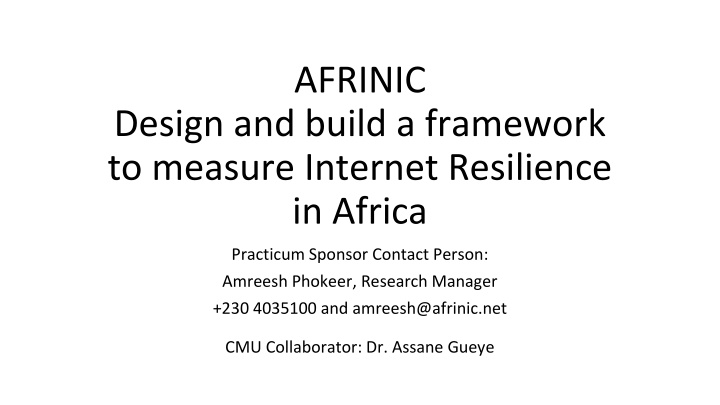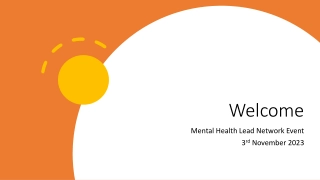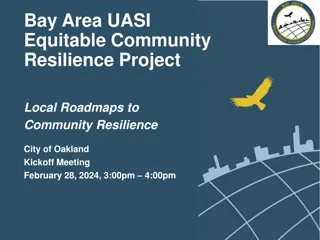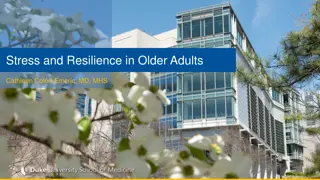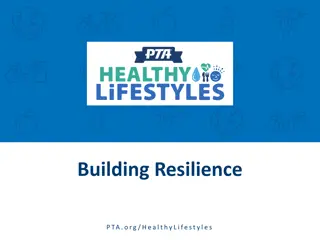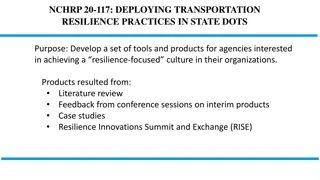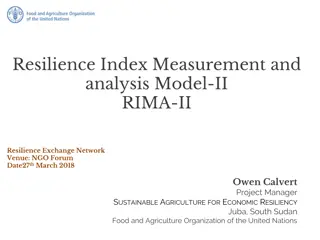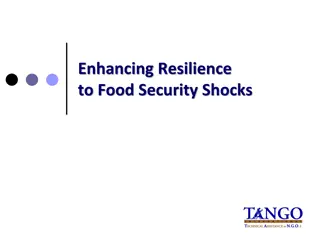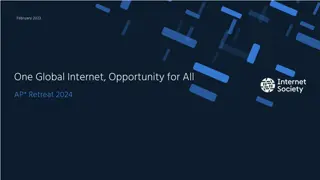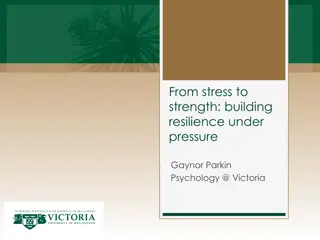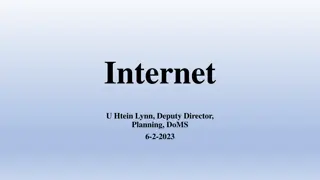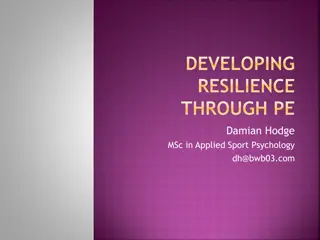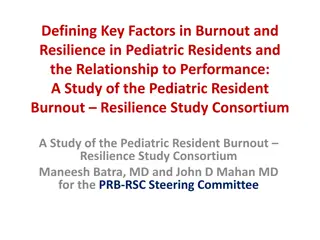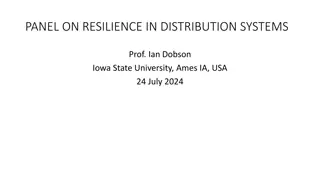Measuring Internet Resilience in Africa Project
AFRINIC focuses on Internet research and innovation in Africa, aiming to enhance Internet infrastructure resilience. The MIRA project assesses the stability of Internet connectivity in African countries, addressing physical infrastructure and network quality of service aspects. Recommendations will be provided for achieving higher resilience levels.
Download Presentation

Please find below an Image/Link to download the presentation.
The content on the website is provided AS IS for your information and personal use only. It may not be sold, licensed, or shared on other websites without obtaining consent from the author.If you encounter any issues during the download, it is possible that the publisher has removed the file from their server.
You are allowed to download the files provided on this website for personal or commercial use, subject to the condition that they are used lawfully. All files are the property of their respective owners.
The content on the website is provided AS IS for your information and personal use only. It may not be sold, licensed, or shared on other websites without obtaining consent from the author.
E N D
Presentation Transcript
AFRINIC Design and build a framework to measure Internet Resilience in Africa Practicum Sponsor Contact Person: Amreesh Phokeer, Research Manager +230 4035100 and amreesh@afrinic.net CMU Collaborator: Dr. Assane Gueye
Information about your organization What does your organization do? AFRINIC is the Regional Internet Registry for Africa. We allocate Internet number resources to network operators. What type of people does your organization serve? Network operators, ISPs, government agencies What does your department or division do? Research and Innovation, Internet Research and Analytics Where are you based? Mauritius
Additional information about your organization AFRINIC is a nonprofit community-driven organisation. We are the Internet Registry for Africa and we allocate Internet Number Resources (IP addresses and Autonomous-System numbers) based on policies brought forward by the community. The aim of the AFRINIC Research department is to foster and participate in research activities about the health of the Internet in Africa by investigating issues of performance, cybersecurity and other policy areas. More information here: https://afrinic.net/research
Background Internet Resilience The Internet plays a critical role in society today. The COVID-19 pandemic has further shown the importance of reliable Internet connectivity. Unfortunately, not all countries have achieved sufficient maturity in terms of having reliable Internet infrastructure. In particular, low-income countries usually have under-provisioned networks and lack proper cable infrastructure or redundant interconnection systems. In such countries (or regions), significant internet outages are experienced whenever there is a cable break or power failure, such that the whole Internet ecosystem is impacted, which can result in significant revenue loss for the digital economy. Unfortunately, many low- income countries do not have the capacity to thoroughly audit their Internet infrastructure and, in many cases, they have not developed or adopted best practices for building resilient Internet infrastructures. The goal of the MIRA (Measuring Internet Resilience in Africa) project is to establish a framework that will evaluate the capability of a country to provide a stable and reliable means of connectivity to the Internet and to continue doing so in the time of crises. Based on the results, we shall provide recommendations in the form of best practices to achieve higher resilience within a network or a country.
Background MIRA Project This practicum is part of the a bigger project called MIRA (Measuring Internet Resilience in Africa) The main objective of the MIRA project is to survey the current state of the Internet in African countries and measure the resilience of the Internet infrastructure (both physical and logical). In the evaluation framework, we will consider the following aspects: 1. The availability and stability of the physical infrastructure, which includes interalia power stations, undersea or terrestrial fiber, landing stations, and last mile access networks, 2. The quality of service (QoS) of the network from the end-user's perspective and the stability of the network in terms of reachability, throughput and latency to selected target servers, 3. The availability and performance of the DNS ecosystem, 4. The presence and efficiency of an IXP and the local peering fabric and finally 5. The resilience of the ISP market i.e. the level of concentration towards specific Autonomous Systems (AS) and affordability.
Proposed Project Overview In this practicum, we will develop tools for aggregating network resilience metrics. Such aggregation will enable us to derived summary values that can quickly and intuitively give indications of network resilience. We will first establish the theoretical foundation of the aggregation by leveraging a ground truth which we plan to define. The ground truth will be built by harnessing expert opinions and then use Machine Learning to extract the common understanding that shall guide the derivation of our aggregation methods. The ground truth will also serve to validate and continually re-calibrate our aggregation tool. Once our metric aggregation methods are established, we will provide the analytics pipeline which defines how the different metrics (measured from different vantage points) will be fed to the aggregation modules. Finally, with sound aggregation of the resilience metrics, network operators will be able to set reference operating point and continually steer the network toward such desired reference value.
Task 1: Theoretical framework In this task, we aim to develop the theoretical foundation for aggregating network resilience metrics. This shall start by identifying the metrics which can be used for effectively assessing systems' overall level of resilience. Then, these metrics will be aggregated to provide a succinct summary of the network resilience. We will build the aggregation tools by answering two main questions: 1. How to aggregate measures of similar metrics taken from different vantage points of the network as well as measures gathered for different metrics of the same network? 2. How to aggregate metrics with a zoom-in/zoom-out effect at different levels such as city, country, and region? The aggregated metric will be mapped to numerical scores that will then be translated into a qualitative representation (such as low, medium, high, and critical) to help organizations properly assess and prioritize their decision processes. To help build the theoretical foundation and validate our theories we will define a ground truth for network resilience metrics.
Task 2: Benchmarking/Ground Truth We propose to develop and document a procedure that follows sound scientific principles and that enables the harnessing of human expert knowledge to build a resilience matrix from the chosen resilience metrics. This procedure will be supported by a computer program that automates the harnessing of human expert opinion and creates the matrix through human computer interaction. Furthermore, it will enable the collaboration of multiple human experts such that the ground truth used for the aggregation process is based on the joint knowledge of the experts. ISOC and AFRINIC maintain databases people who are the experts in this domain. We propose to provide them our process and associated tools to enable them to assess the accuracy of our aggregation scores (to compare what their expert opinion says a score should be against what the score actually is). As human experience grows and our understanding of network resilience changes, the true scores themselves change (as based on the human expert opinion). The result is that our ground truth and our metrics will change over time. By using this new knowledge, we will systematically re-calibrate and improve our aggregate methods.
Project data Most data will come from open Internet data sources. Where not available, we will use Internet Measurement techniques to gather primary sources of information. List of available data sources: http://www.routeviews.org/routeviews/ https://www.submarinecablemap.com/ https://www.itu.int/itu-d/tnd-map-public/ https://bgpstream.caida.org/ https://www.pch.net/resources/Routing_Data/ https://atlas.ripe.net/
Proposed Project Outcome Describe the specific outcomes you expect from this project Outcome 1: Theoretical framework for metric aggregation Outcome 2: Expert knowledge harnessing tool Outcome 3: ML solutions that mine data and build ground truth What documents, systems built, or reports will be created or generated? If time allows, we can aim at having a dashboard showing how different countries are performing in terms of Internet Resilience. An example of such as dashboard is here. Or what technologies or systems will be prototyped, piloted, or put into operation? Expert knowledge harnessing tool ML Algorithms for metric aggregation
Technology Skills Required How to build an index by aggregating multiple sub-indices Machine Learning Python programming Data visualization (Apache Superset, D3, HighCharts, etc)
Challenges and Risks The training dataset will depend on the contribution of experts from the African Internet community. Feedback from experts will be obtained through surveys on a voluntary basis. We will need to make sure we have enough feedback in due time. This project will depend on the availability of secondary Internet Resilience data sources. The data need to be pre-processed before applying any Machine Learning algorithm. This pre-processing step will be done by AFRINIC, so this represents a dependency.
Preliminary Work Plan Task Jan Feb Mar Apr May Project definition and submission X Definition of network metrics and research aggregation techniques X Gather Ground truth and build the theoretical framework X Apply Machine Learning techniques and validate the model X X Wrap up and paper writing X
